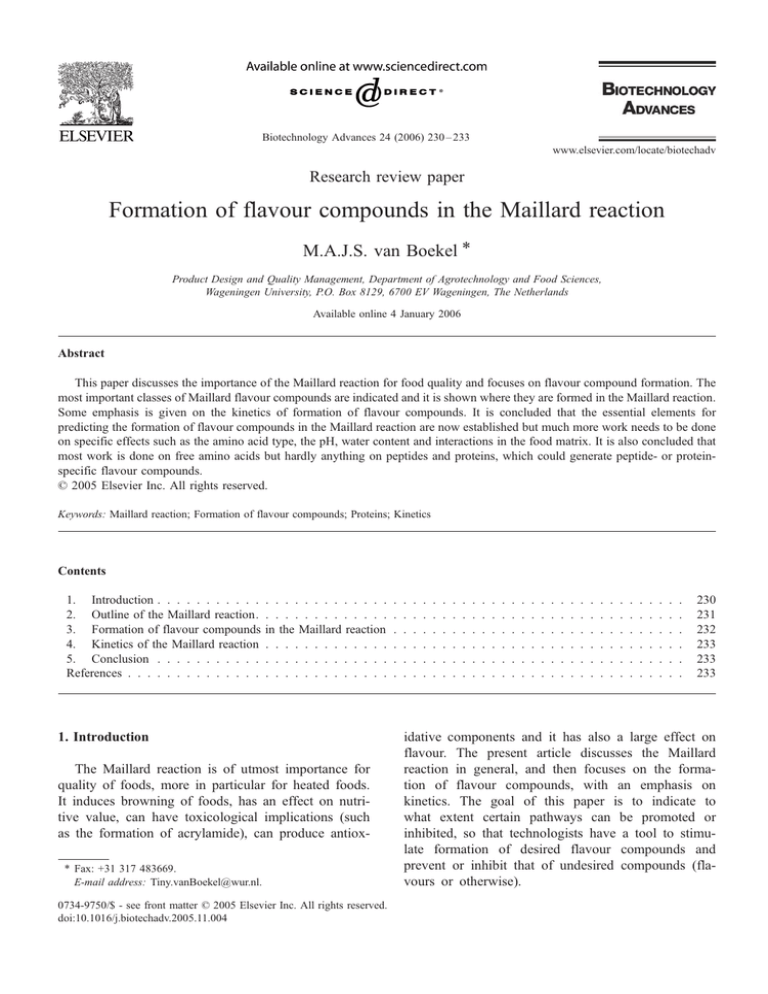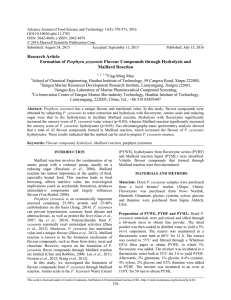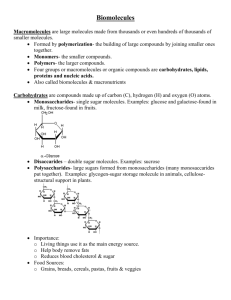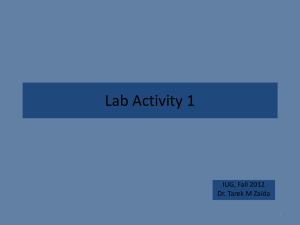
Biotechnology Advances 24 (2006) 230 – 233
www.elsevier.com/locate/biotechadv
Research review paper
Formation of flavour compounds in the Maillard reaction
M.A.J.S. van Boekel *
Product Design and Quality Management, Department of Agrotechnology and Food Sciences,
Wageningen University, P.O. Box 8129, 6700 EV Wageningen, The Netherlands
Available online 4 January 2006
Abstract
This paper discusses the importance of the Maillard reaction for food quality and focuses on flavour compound formation. The
most important classes of Maillard flavour compounds are indicated and it is shown where they are formed in the Maillard reaction.
Some emphasis is given on the kinetics of formation of flavour compounds. It is concluded that the essential elements for
predicting the formation of flavour compounds in the Maillard reaction are now established but much more work needs to be done
on specific effects such as the amino acid type, the pH, water content and interactions in the food matrix. It is also concluded that
most work is done on free amino acids but hardly anything on peptides and proteins, which could generate peptide- or proteinspecific flavour compounds.
D 2005 Elsevier Inc. All rights reserved.
Keywords: Maillard reaction; Formation of flavour compounds; Proteins; Kinetics
Contents
1. Introduction . . . . . . . . . . .
2. Outline of the Maillard reaction.
3. Formation of flavour compounds
4. Kinetics of the Maillard reaction
5. Conclusion . . . . . . . . . . .
References . . . . . . . . . . . . . .
. . . . . . . . . . . . .
. . . . . . . . . . . . .
in the Maillard reaction
. . . . . . . . . . . . .
. . . . . . . . . . . . .
. . . . . . . . . . . . .
1. Introduction
The Maillard reaction is of utmost importance for
quality of foods, more in particular for heated foods.
It induces browning of foods, has an effect on nutritive value, can have toxicological implications (such
as the formation of acrylamide), can produce antiox* Fax: +31 317 483669.
E-mail address: Tiny.vanBoekel@wur.nl.
0734-9750/$ - see front matter D 2005 Elsevier Inc. All rights reserved.
doi:10.1016/j.biotechadv.2005.11.004
.
.
.
.
.
.
.
.
.
.
.
.
.
.
.
.
.
.
.
.
.
.
.
.
.
.
.
.
.
.
.
.
.
.
.
.
.
.
.
.
.
.
.
.
.
.
.
.
.
.
.
.
.
.
.
.
.
.
.
.
.
.
.
.
.
.
.
.
.
.
.
.
.
.
.
.
.
.
.
.
.
.
.
.
.
.
.
.
.
.
.
.
.
.
.
.
.
.
.
.
.
.
.
.
.
.
.
.
.
.
.
.
.
.
.
.
.
.
.
.
.
.
.
.
.
.
.
.
.
.
.
.
.
.
.
.
.
.
.
.
.
.
.
.
.
.
.
.
.
.
.
.
.
.
.
.
.
.
.
.
.
.
.
.
.
.
.
.
.
.
.
.
.
.
.
.
.
.
.
.
230
231
232
233
233
233
idative components and it has also a large effect on
flavour. The present article discusses the Maillard
reaction in general, and then focuses on the formation of flavour compounds, with an emphasis on
kinetics. The goal of this paper is to indicate to
what extent certain pathways can be promoted or
inhibited, so that technologists have a tool to stimulate formation of desired flavour compounds and
prevent or inhibit that of undesired compounds (flavours or otherwise).
M.A.J.S. van Boekel / Biotechnology Advances 24 (2006) 230–233
231
paths taking place depend strongly on temperature,
pH and nature of the reactants (i.e., type of sugar,
type of amino acid, or protein). A general overview is
given in Fig. 1. It should be noted that in the case of
proteins or peptides the reactive amino group is the amino group of lysine, because the a-amino groups are
tied up in the peptide bond and are not available for the
Maillard reaction nor the Strecker reaction. This results
in a different behaviour of amino acids compared to
proteins and peptides. In the case of proteins, the
Maillard reaction often leads to crosslink formation,
while brown pigments are for a large part covalently
attached to proteins (Brands et al., 2002).
The general scheme of the Maillard reaction, more
or less summarized in Fig. 1, is under debate. For
instance, the central role of Amadori/Heyns products
given in most schemes is not undisputed. It may be
that these products are just relatively stable intermediates but not essential for the progress of the Maillard
reaction. Deoxyosones on the other hand are considered as essential intermediates (e.g., Weenen, 1998;
Martins and van Boekel, 2005). An alternative view
on the Maillard reaction has been given by Yaylayan
(1997) who considers the initial stage as three primary
2. Outline of the Maillard reaction
The Maillard reaction is usually divided into three
stages. The initial stage starts with a condensation
between an amino group and a reducing sugar, leading
to an N-glycosylamine in the case of an aldose sugar
that rearranges into the so-called Amadori product (or
Heyns product if the reducing sugar is a ketose). The
intermediate stage starts from the Amadori/Heyns product, leading to sugar fragmentation products and release
of the amino group. The final stage leads to all kinds of
dehydration, fragmentation, cyclization and polymerisation reactions in which amino groups participate
again. Especially in relation to flavour formation, the
so-called Strecker degradation is of utmost importance,
in which amino acids are degraded by dicarbonyls
formed in the Maillard reaction, leading to deamination
and decarboxylation of the amino acid. It should also be
mentioned that sugar degradation reactions in the absence of amino groups (caramelisation) lead to similar
products, but in the Maillard reaction, the amino group
acts as a catalyst, so that the Maillard reaction results in
a faster reaction and higher amounts of very reactive
intermediate products. The various possible reaction
Sugar + Amino group
N-glycosylamine/N-fructosylamine
Amadori/Heyns rearrangement
Amadori rearrangement product/Heyns rearrangement product
Amino group
Furfural
(pentoses)
Deoxyosones
Hydroxymethylfurfural
Sugar fragmentation
(hexoses)
Reductones+ dehydroreductones
Retro-aldolization
NH 3 H2S
amino acid
Furanones
Hydroxyacetone
Glyoxal
Strecker
Pyranones
Cyclotene
Pyruvaldehyde
reaction
Pyrroles
Dihydroxyacetone
Glycolaldehyde
Thiophenes
Hydroxyacetyl
Glyceraldehyde
Aldehydes + aminoketones
acetoin
heterocyclization
Pyridines
Thiazoles
Pyrazines
Pyrroles
Oxazoles
Imidazoles
Fig. 1. General overview of the Maillard reaction showing flavour compounds as end products (after Ho, 1996).
232
M.A.J.S. van Boekel / Biotechnology Advances 24 (2006) 230–233
Table 1
Overview of some classes of Maillard-derived flavour compounds
Compound class
Associated flavour/aroma
Food examples
Pyrazines
Alkylpyrazines
Alkylpyridines
Acylpyridines
Pyrroles
Furans, furanones, pyranones
Oxazoles
Thiofenes
Cooked, roasted, toasted, baked cereals
Nutty, roasted
Green, bitter, astringent, burnt
Cracker-like
Cereal-like
Sweet, burnt, pungent, caramel-like
Green, nutty, sweet
Meaty
Heated foods in general
Coffee
Coffee, barley, malt
Cereal products
Cereals, coffee
Heated foods in general
Cocoa, coffee, meat
Heated meat
fragmentation pools arising from sugars, amino acids
and Amadori/Heyns products. The Maillard reaction
then propagates by interactions between the different
pools to generate low and high molecular weight end
products.
3. Formation of flavour compounds in the Maillard
reaction
Flavour compound formation in the Maillard reaction depends on (1) the type of sugars and amino acids
involved, and (2) on reaction temperature, time, pH and
water content (Jousse et al., 2002). In general, the first
factor mentioned determines the type of flavour compounds formed, while the second factor influences the
kinetics. Some examples of the first factor are that
meat-related flavour compounds are mainly sulphurcontaining compounds, derived from cysteine and ribose (coming from nucleotides), while the amino acid
proline gives rise to typical bread, rice and popcorn
flavours.
Generally regarded as unpleasant
Typical for heated meat,
formed from ribose and cysteine
Many Strecker aldehydes themselves are important
for food flavour, but also all kinds of reaction products
derived from them. Table 1 gives an overview of some
important classes, while Fig. 1 indicates where they are
formed in the Maillard reaction.
It should be noted that most of the research on the
formation of Maillard-based flavour compounds is on
mixtures of sugar and free amino acids, and hardly on
sugar–protein or sugar–peptide mixtures. In 1992, Izzo
and Ho wrote: dthe roles in aroma generation of amino
acids bound in proteins and peptides have not been
studied to an appreciable extentT. Thirteen years later
this is still the case. With peptides and proteins, and in
the absence of free amino acids, the Strecker reaction
cannot take place, and this has consequences for flavour
generation. According to Izzo and Ho (1992), peptidespecific flavour compounds may be formed in the
Maillard reaction. In principle, free amino acids may
be generated during heating from proteins or peptides if
hydrolysis occurs, but this will be limited during normal heat treatments of foods. What remains is that sugar
sugar
R1
Remarks
Amino acid
R2
Sugar degradation
products
Amadori rearrangement
product
R3
R4
R7
Strecker intermediate
Rearranged sugars
R5
pyrroles
furans
R6
carbonyls
R8
Strecker
aldehydes
R9
pyrrazines
Fig. 2. Kinetic model with essential rate-determining steps R1–R9 describing the formation of the most important Maillard reaction flavour
compounds (based on Jousse et al., 2002).
M.A.J.S. van Boekel / Biotechnology Advances 24 (2006) 230–233
degradation products can react with the q-amino groups
of lysine residues, but also with other amino acid side
chains, such as arginine and tryptophan. It is also
known that the Maillard reaction in milk-based products leads to undesired flavour compounds (Morr and
Ha, 1991); these milk-based products hardly contain
free amino acids, and therefore the Maillard reaction
will take place mainly via the lysine side chains.
4. Kinetics of the Maillard reaction
The kinetics of the Maillard reaction is very complicated due to the many reaction paths and effect of
processing conditions. The traditional approach of applying simple kinetics (zero-, first-, or second-order
behaviour) is not very helpful because it pertains to
only one single step. Rather, kinetic modelling can be
done in a more fruitful way via multiresponse modelling in which many steps are analysed simultaneously
(e.g., Martins and van Boekel, 2005), be it that this kind
of work has focused until now on browning reactions
rather than on flavour compound formation. An interesting approach can be found in Jousse et al. (2002)
who focused on kinetics of flavour compound formation. They were able to derive a more or less generic
model based on a compilation of literature sources. The
kinetic model resembles the scheme in Fig. 1, but is
simplified and considers 9 essential rate-determining
steps for the formation of flavour compounds. It is
shown in Fig. 2.
In order to be able to apply such models to practical
situations, an even more comprehensive model is needed, because the Maillard reaction does not only lead to
flavour compounds but also to coloured compounds
and other interesting compounds such as acrylamide,
the formation of which should be minimized, obviously. So, it seems that a coupling of the various models
that are now published in literature is a next step in
233
developing a tool for product and process design. With
such a tool, it should be possible to predict the formation of desired flavour and coloured compounds, as
well as that of undesired compounds (which could
also be flavour compounds).
5. Conclusion
The formation of flavour compounds in the Maillard
reaction is very complicated. The general chemical
pathways leading to classes of compounds are more
or less known, but it is still unknown how reaction
pathways can be directed in a desired way. Also, most
of the papers published on this topic are using model
systems rather than real foods. The effects of the food
matrix, including effects of pH, water content, specific
catalysis, are still largely unknown.
References
Brands CMJ, Wedzicha BL, van Boekel MAJS. Quantification of
melanoidin concentration in sugar–casein systems. J Agric Food
Chem 2002;50:1178 – 83.
Ho C-T. Thermal generation of Maillard aromas. In: Ikan R, editor.
The Maillard reaction Consequences for the chemical and life
sciences. Wiley; 1996. p. 27 – 53.
Izzo HV, Ho C-T. Peptide-specific Maillard reaction products: a new
pathway for flavour chemistry. Trends Food Sci Technol 1992;3:
253 – 7.
Jousse F, Jongen W, Agterof W, Russell S, Braat P. Simplified kinetic
scheme of flavour formation by the Maillard reaction. J Food Sci
2002;67:2534 – 42.
Martins SIFS, van Boekel MAJS. Kinetics of the glucose–glycine
Maillard reaction pathways: influences of pH and reactant initial
concentrations. Food Chem 2005;92:437 – 48.
Morr CV, Ha EYW. Off-flavors of whey protein concentrates: a
literature review. Int Dairy J 1991;1:1 – 11.
Yaylayan VA. Classification of the Maillard reaction: a conceptual
approach. Trends Food Sci Technol 1997;8:13 – 8.
Weenen H. Reactive intermediates and carbohydrate fragmentation in
Maillard chemistry. Food Chem 1998;62:393 – 401.




